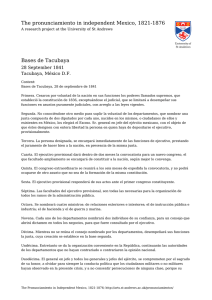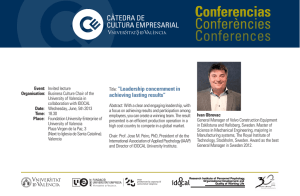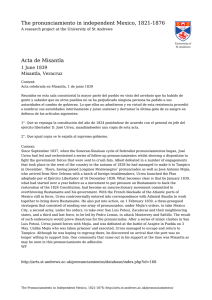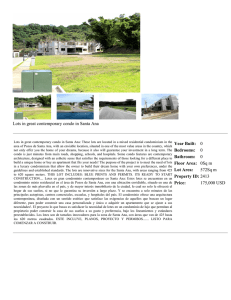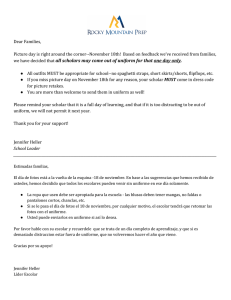to a PDF version of this pronunciamiento
Anuncio
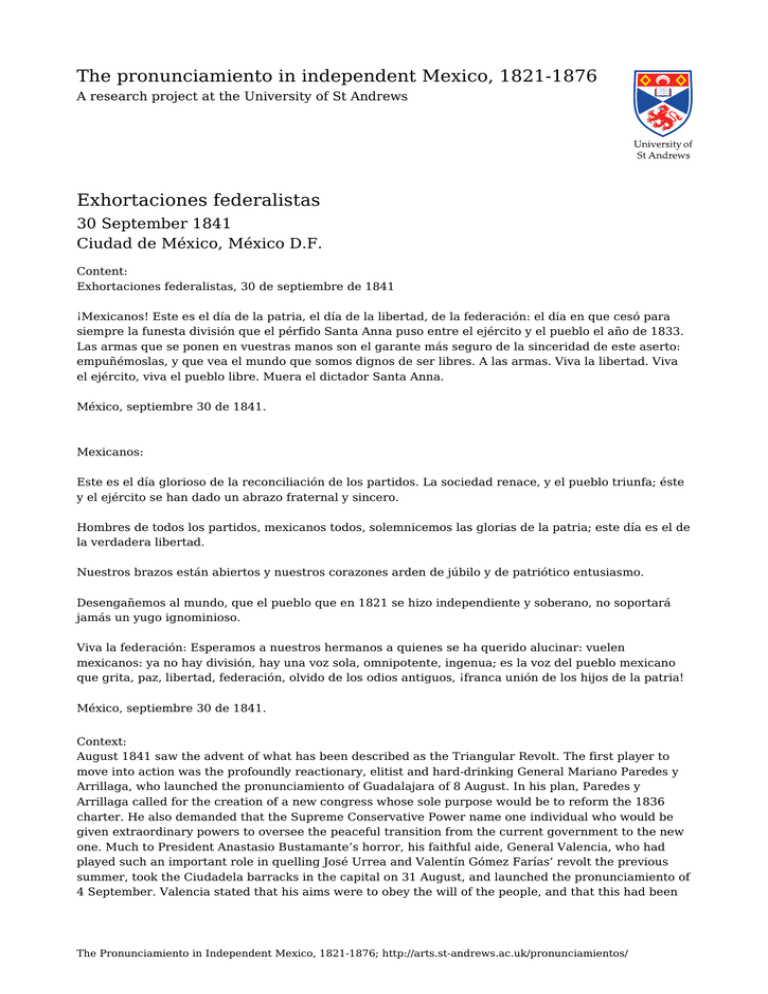
The pronunciamiento in independent Mexico, 1821-1876 A research project at the University of St Andrews Exhortaciones federalistas 30 September 1841 Ciudad de México, México D.F. Content: Exhortaciones federalistas, 30 de septiembre de 1841 ¡Mexicanos! Este es el día de la patria, el día de la libertad, de la federación: el día en que cesó para siempre la funesta división que el pérfido Santa Anna puso entre el ejército y el pueblo el año de 1833. Las armas que se ponen en vuestras manos son el garante más seguro de la sinceridad de este aserto: empuñémoslas, y que vea el mundo que somos dignos de ser libres. A las armas. Viva la libertad. Viva el ejército, viva el pueblo libre. Muera el dictador Santa Anna. México, septiembre 30 de 1841. Mexicanos: Este es el día glorioso de la reconciliación de los partidos. La sociedad renace, y el pueblo triunfa; éste y el ejército se han dado un abrazo fraternal y sincero. Hombres de todos los partidos, mexicanos todos, solemnicemos las glorias de la patria; este día es el de la verdadera libertad. Nuestros brazos están abiertos y nuestros corazones arden de júbilo y de patriótico entusiasmo. Desengañemos al mundo, que el pueblo que en 1821 se hizo independiente y soberano, no soportará jamás un yugo ignominioso. Viva la federación: Esperamos a nuestros hermanos a quienes se ha querido alucinar: vuelen mexicanos: ya no hay división, hay una voz sola, omnipotente, ingenua; es la voz del pueblo mexicano que grita, paz, libertad, federación, olvido de los odios antiguos, ¡franca unión de los hijos de la patria! México, septiembre 30 de 1841. Context: August 1841 saw the advent of what has been described as the Triangular Revolt. The first player to move into action was the profoundly reactionary, elitist and hard-drinking General Mariano Paredes y Arrillaga, who launched the pronunciamiento of Guadalajara of 8 August. In his plan, Paredes y Arrillaga called for the creation of a new congress whose sole purpose would be to reform the 1836 charter. He also demanded that the Supreme Conservative Power name one individual who would be given extraordinary powers to oversee the peaceful transition from the current government to the new one. Much to President Anastasio Bustamante’s horror, his faithful aide, General Valencia, who had played such an important role in quelling José Urrea and Valentín Gómez Farías’ revolt the previous summer, took the Ciudadela barracks in the capital on 31 August, and launched the pronunciamiento of 4 September. Valencia stated that his aims were to obey the will of the people, and that this had been The Pronunciamiento in Independent Mexico, 1821-1876; http://arts.st-andrews.ac.uk/pronunciamientos/ eloquently expressed in the pronunciamiento of Guadalajara. Valencia proclaimed that the people did not want a tyrant and he went on to stress the need to forge a new constituent congress. Unlike Paredes y Arrillaga, who believed the Supreme Conservative Power should name a provisional president, Valencia believed such an individual should be chosen by a popular junta. In response to Valencia’s pronunciamiento, the Supreme Conservative Power gave Bustamante emergency powers, and he immediately set about organizing the defence of the government, declaring the capital to be in a state of siege. On 9 September, from the Fortress of San Carlos in Perote, Santa Anna made his own revolutionary plan known and started his march towards the capital. In the open letter addressed to Bustamante in the form of a published pamphlet on 13 September, including a copy of his Plan of Perote of the 9th, he justified his decision to take up arms against the government. He claimed that the 1836 Constitution had never been in accordance with his principles, or those that inspired the plans that brought about the end of the radical government of 1833. By resting all power away from the executive, the new constitution made governing Mexico at a time of conflict a near impossibility. The urgent responses required to organise an army, tackle the country’s significant diplomatic problems with France and reform the country’s financial and judicial systems were simply not possible under the Seven Laws. With adventurers still running amok in Texas, and with Tabasco and Yucatán up in flames, it was about time the government became “strong and vigorous.” Texas was waiting to be re-conquered. The constitution needed to be reformed. Tabasco and Yucatán had to be brought back into the fold. He reminded Bustamante that he had offered to mediate between him and the rebels. He criticised the president for ignoring his letters. He had been given no choice but to join the revolutionary movement. Proving his point that the 1836 Constitution did not work, he accused the Supreme Conservative Power, of all institutions, of being in breach of article 18. of the 1836 charter for having given Bustamante emergency powers. As was expressed in the actual Plan of Perote of 9 September, Santa Anna was demanding the removal of Bustamante as the head of the executive, that General Valencia’s Plan of 4 September was endorsed, and that all Mexicans should leave aside their factional differences and join in a “conciliatory embrace.” Despite Bustamante’s attempts to resist the revolt it became evident that he was alone as Paredes y Arrillaga and Santa Anna’s respective forces made their way to the capital to join Valencia. By 27 September, the three rebel forces converged in the Archbishop’s Palace in Tacubaya, in the outskirts of Mexico City. Having succeeded in forcing Bustamante to accept a truce, Paredes y Arrillaga, Valencia and Santa Anna thrashed out what was to become the Bases de Tacubaya reproduced here. With this plan, promulgated on 29 September, a temporary dictatorship was to be established with the objective of calling a new Congress to devise a new constitution. Despite Paredes y Arrillaga and Valencia’s ambitions, Santa Anna managed to persuade them to let him take the lead once more. In a final and desperate bid to rally support for his cause, Bustamante proclaimed the restoration of the federalist charter on 30 September. (Although Bustamante’s federalist pronunciamiento was not formally launched until 1 October, as may be seen from the document reproduced here, the call to oppose Santa Anna’s dictatorship and for a return to federalism was voiced on the last day of September). Hoping this would inspire the moderate and radical federalists to come to his aid, Bustamante reorganized his defences, and between 2 and 4 October the capital was exposed once more to the horrors of war. Cannons once again pounded the city centre and there were bloody street fights. In the end, Bustamante was forced to face the inevitable. He finally met with Santa Anna at Punta del Río on 5 October, outside Mexico City, and they formally agreed the following day to end all hostilities, with Bustamante accepting the Bases de Tacubaya and agreeing to be replaced by Santa Anna as provisional president. On 7 October, Santa Anna marched into a battered, tired and distrustful Mexico City and, following his investiture ceremony on 10 October 1841 initiated what would be his longest and most successful term in office (1841-43, 1843-44). WF http://arts.st-andrews.ac.uk/pronunciamientos/database/index.php?id=240 The Pronunciamiento in Independent Mexico, 1821-1876; http://arts.st-andrews.ac.uk/pronunciamientos/
